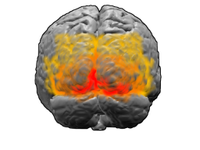
Photo from wikipedia
&NA; The study of correlations between brain regions is an important chapter of the analysis of large‐scale brain spatiotemporal dynamics. In particular, novel methods suited to extract dynamic changes in… Click to show full abstract
&NA; The study of correlations between brain regions is an important chapter of the analysis of large‐scale brain spatiotemporal dynamics. In particular, novel methods suited to extract dynamic changes in mutual correlations are needed. Here we scrutinize a recently reported metric dubbed “Multiplication of Temporal Derivatives” (MTD) which is based on the temporal derivative of each time series. The formal comparison of the MTD formula with the Pearson correlation of the derivatives reveals only minor differences, which we find negligible in practice. A comparison with the sliding window Pearson correlation of the raw time series in several stationary and non‐stationary set‐ups, including a realistic stationary network detection, reveals lower sensitivity of derivatives to low frequency drifts and to autocorrelations but also lower signal‐to‐noise ratio. It does not indicate any evident mathematical advantages of the proposed metric over commonly used correlation methods. Graphical abstract Figure. No caption available.
Journal Title: NeuroImage
Year Published: 2019
Link to full text (if available)
Share on Social Media: Sign Up to like & get
recommendations!